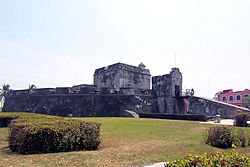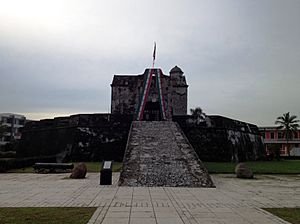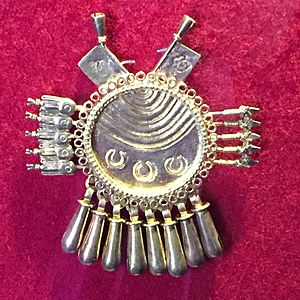Baluarte de Santiago facts for kids
Quick facts for kids Bastion of Santiago |
|
|---|---|
| Baluarte de Santiago Baluarte de la Pólvora |
|
| Veracruz, Veracruz, Mexico | |
 |
|
| Coordinates | 19°11′53.16″N 96°7′59.88″W / 19.1981000°N 96.1333000°W |
| Type | Bastion |
| Site information | |
| Owner | INAH |
| Open to the public |
No, temporarily closed |
| Status | Museo Baluarte de Santiago |
| Site history | |
| Built | 1635 |
| Built for | Protection of the walled city of Veracruz |
The Baluarte de Santiago is a cool old fort in Veracruz, Mexico. Its name means "Bastion of Santiago" in Spanish. People also call it the "gunpowder bastion" because it stored gunpowder. This strong building is the only one left of nine similar forts that once protected the city's port. It kept the city safe from pirate and privateer attacks long ago. You can find it on Francisco Canal Street, between Gómez Farías and 16 Septiembre Avenues.
History of the Fort
This military building was finished in 1635. The Baluarte de Santiago was one of seven strong forts that made up the defense system for the walled city of Veracruz. It stood at the southern end of the city, right by the Gulf of Mexico. For many years, from the 1600s to the 1800s, these forts protected Veracruz from pirate attacks.
In 1990, the bastion was updated to become a museum. It opened its doors in 1991 and has been a museum ever since. Today, it is known as the Museo Baluarte de Santiago.
The Fisherman's Jewels
The Joyas del Pescador, which means "The Fisherman's Jewels," are amazing ancient pieces of jewelry. An octopus fisherman named Raúl Hurtado found them in 1976. He discovered them about 20 kilometers north of Veracruz city, inside an old Spanish shipwreck.
The fisherman had to sell the jewels, and they ended up with a jeweler. Sadly, the jeweler melted some of the pieces to make graduation rings. Luckily, the police were investigating a jewelry theft in the city. They noticed these jewels looked very different from modern ones.
Experts from the University of Veracruz and INAH (Mexico's National Institute of Anthropology and History) confirmed that the jewels were indeed ancient treasures. The pieces were then taken care of and became property of INAH. The treasure included 42 gold pieces from the Mixtec people, still in their original shape. Plus, there were 23 more gold pieces that the jeweler had melted. In total, there were 65 pieces, weighing over 7 kilograms!
The Joyas del Pescador have been on display at the Museo Baluarte de Santiago since 1991. They are a permanent exhibition, meaning you can still see them there today.
See also
 In Spanish: Baluarte de Santiago para niños
In Spanish: Baluarte de Santiago para niños



